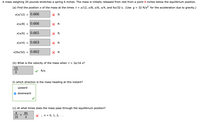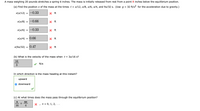
College Physics
11th Edition
ISBN: 9781305952300
Author: Raymond A. Serway, Chris Vuille
Publisher: Cengage Learning
expand_more
expand_more
format_list_bulleted
Concept explainers
Question
thumb_up100%

Transcribed Image Text:A mass weighing 20 pounds stretches a spring 6 inches. The mass is initially released from rest from a point 8 inches below the equilibrium position.
(a) Find the position x of the mass at the times t = 1/12, x/8, n/6, n/4, and 97/32 s. (Use g = 32 ft/s2 for the acceleration due to gravity.)
x(1/12) = 0.666
X ft
X(x/8) = 0.666
X ft
x(x/6) = 0.665
X ft
x (π/4)
0.663
X ft
=
x(9л/32)
0.662
X ft
(b) What is the velocity of the mass when t = 3x/16 s?
16
ft/s
3
In which direction is the mass heading at this instant?
upward
downward
(c) At what times does the mass pass through the equilibrium position?
16
4
X , n = 0, 1, 2, .

Transcribed Image Text:A mass weighing 20 pounds stretches a spring 6 inches. The mass is initially released from rest from a point 8 inches below the equilibrium position.
(a) Find the position x of the mass at the times t = n/12, n/8, n/6, a/4, and 97/32 s. (Use g = 32 ft/s? for the acceleration due to gravity.)
X(1/12) =
-0.33
X ft
x(x/8) =
-0.66
X ft
x(л/6) %3
-0.33
X ft
x(T/4) =
0.66
X ft
x(9x/32) =
0.47
X ft
(b) What is the velocity of the mass when t = 37/16 s?
16
ft/s
3
In which direction is the mass heading at this instant?
upward
downward
(c) At what times does the mass pass through the equilibrium position?
16
4
X , n = 0, 1, 2,
+
Expert Solution
This question has been solved!
Explore an expertly crafted, step-by-step solution for a thorough understanding of key concepts.
Step by stepSolved in 5 steps with 6 images

Knowledge Booster
Learn more about
Need a deep-dive on the concept behind this application? Look no further. Learn more about this topic, physics and related others by exploring similar questions and additional content below.Similar questions
- A mass weighing 24 pounds, attached to the end of a spring, stretches it 4 inches. Initially, the mass is released from rest from a point 4 inches above the equilibrium position. Find the equation of motion. (Use g = 32 ft/s2 for the acceleration due to gravity.) cos(4√6)t x(t) = Need Help? Read It X ft Watch Itarrow_forwardThe scale of a spring balance that reads from 0 to 36.1 kg is 24.1 cm long. A package suspended from the balance is found to oscillate vertically with a frequency of 2.21 Hz. (a) What is the spring constant? (b) How much does the package weigh?arrow_forwardA 5.75-kg mass stretches a vertical spring 0.5 m. If the spring is stretched an additional 1 m and released, how long does it take to reach the (new) equilibrium position again? (How do I find the amount of time?)arrow_forward
- It compresses the spring 5.3 cm before coming to a stop.arrow_forwardA mass weighting 32 lbs stretches a spring 8 inches. The mass is in a medium that exerts a viscous resistance of 38 lbs when the mass has a velocity of 4 ft/sec. Suppose the object is displaced an additional 6 inches and released. Find an equation for the object's displacement, u(t), in feet after t seconds. u(t) =arrow_forwardA mass weighting 16 lbs stretches a spring 6 inches. The mass is in a medium that exerts a viscous resistance of 1 lbs when the mass has a velocity of 2 ft/sec. Suppose the object is displaced an additional 3 inches and released. Find an equation for the object's displacement, u(t), in feet after t seconds. u(t) =arrow_forward
- A 3kg weight is attached to a spring with constant k= 48 kg /m and subjected to an external force F(t) = 42 cos(3t). The weight begins at rest in its equilibrium position. Find its displacement for t>0 , with y(t) measured positive upwards.arrow_forwardIf the mass is 48kg and the spring constant is 12n/m,what is the period of oscillation?arrow_forwardA simple pendulum oscillates with a frequency of 6.1 Hz. How long (in centimeters) is the pendulum?arrow_forward
- A mass m = 1.9 kg is at the end of a horizontal spring on a frictionless horizontal surface. The mass is oscillating with an amplitude A = 4.5 cm and a frequency f = 1.05 Hz. Part (a) Write an equation for the spring constant k. Part (b) Calculate the spring constant k, in Newtons per meter. Part (c) Write an equation for the total mechanical energy, E, of the motion. Your expression should be in terms of the variables in the original problem statement. Part (d) Calculate the total mechanical energy E, in joules.arrow_forwardhass weighing 20 pounds stretches a spring 6 inches. The mass is initially released from rest from a point 9 inches below the equilibrium position. (a) Find the position x of the mass at the timest= 1/12, 1/8, 1/6, 11/4, and 91/32 s. (Use g = 32 ft/s? for the acceleration due to gravity.) x(n/12) = ft x(n/8) = ft x(п/6) — ft x(п/4) — ft x(9n/32) ft (b) What is the velocity of the mass when t = 3t/16 s? ft/s In which direction is the mass heading at this instant? O downward O upward (c) At what times does the mass pass through the equilibrium position? п 3D 0, 1, 2, ..arrow_forward
arrow_back_ios
arrow_forward_ios
Recommended textbooks for you
 College PhysicsPhysicsISBN:9781305952300Author:Raymond A. Serway, Chris VuillePublisher:Cengage Learning
College PhysicsPhysicsISBN:9781305952300Author:Raymond A. Serway, Chris VuillePublisher:Cengage Learning University Physics (14th Edition)PhysicsISBN:9780133969290Author:Hugh D. Young, Roger A. FreedmanPublisher:PEARSON
University Physics (14th Edition)PhysicsISBN:9780133969290Author:Hugh D. Young, Roger A. FreedmanPublisher:PEARSON Introduction To Quantum MechanicsPhysicsISBN:9781107189638Author:Griffiths, David J., Schroeter, Darrell F.Publisher:Cambridge University Press
Introduction To Quantum MechanicsPhysicsISBN:9781107189638Author:Griffiths, David J., Schroeter, Darrell F.Publisher:Cambridge University Press Physics for Scientists and EngineersPhysicsISBN:9781337553278Author:Raymond A. Serway, John W. JewettPublisher:Cengage Learning
Physics for Scientists and EngineersPhysicsISBN:9781337553278Author:Raymond A. Serway, John W. JewettPublisher:Cengage Learning Lecture- Tutorials for Introductory AstronomyPhysicsISBN:9780321820464Author:Edward E. Prather, Tim P. Slater, Jeff P. Adams, Gina BrissendenPublisher:Addison-Wesley
Lecture- Tutorials for Introductory AstronomyPhysicsISBN:9780321820464Author:Edward E. Prather, Tim P. Slater, Jeff P. Adams, Gina BrissendenPublisher:Addison-Wesley College Physics: A Strategic Approach (4th Editio...PhysicsISBN:9780134609034Author:Randall D. Knight (Professor Emeritus), Brian Jones, Stuart FieldPublisher:PEARSON
College Physics: A Strategic Approach (4th Editio...PhysicsISBN:9780134609034Author:Randall D. Knight (Professor Emeritus), Brian Jones, Stuart FieldPublisher:PEARSON

College Physics
Physics
ISBN:9781305952300
Author:Raymond A. Serway, Chris Vuille
Publisher:Cengage Learning

University Physics (14th Edition)
Physics
ISBN:9780133969290
Author:Hugh D. Young, Roger A. Freedman
Publisher:PEARSON

Introduction To Quantum Mechanics
Physics
ISBN:9781107189638
Author:Griffiths, David J., Schroeter, Darrell F.
Publisher:Cambridge University Press

Physics for Scientists and Engineers
Physics
ISBN:9781337553278
Author:Raymond A. Serway, John W. Jewett
Publisher:Cengage Learning

Lecture- Tutorials for Introductory Astronomy
Physics
ISBN:9780321820464
Author:Edward E. Prather, Tim P. Slater, Jeff P. Adams, Gina Brissenden
Publisher:Addison-Wesley

College Physics: A Strategic Approach (4th Editio...
Physics
ISBN:9780134609034
Author:Randall D. Knight (Professor Emeritus), Brian Jones, Stuart Field
Publisher:PEARSON